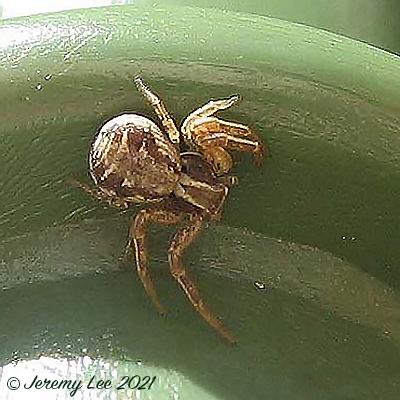
 |
|
Scientific Classifications explained » Amphibians » Ants » Aphids » Bees » Beetles » Birds » Bugs » Butterflies » Caterpillars » Damselflies » Dragonflies » Earwigs » Flies » Frog/Leafhoppers » Fungi » Galls » Grasshoppers » Harvestmen » Hoverflies » Lacewings » Ladybirds » Leaf Mines » Lichens » Mammals » Millipedes » Mosses » Moths » Sawflies » Slugs » Snails » Spiders » Trees & Shrubs » Wasps » Wild Flowers » Woodlice » Postboxes |
UK Nature > Spiders > Xysticus cristatus

Scientific Name: Xysticus cristatus Common Name: Crab Spider The crab spider Xysticus cristatus occurs in almost every habitat type, but is shade intolerant and rare in woodlands and closed canopy habitats. Large numbers can be found in grasslands and habitats which have undergone some degree of disturbance such as quarries and agricultural fields. In grasslands, this spider exploits a flexible hunting position either at the tips of vegetation or on the ground surface. As a consequence, the diet is extremely varied and comprises flying insects, including bees and butterflies when positioned in flower-heads, or ants, spiders and other soft bodied prey when ambushing prey on the ground. Immatures have been found ballooning, particularly between the months of July to September. Adults have been recorded from February to December, with a male activity peak in May and June. The species is widespread throughout most of Britain. |
|

https://www.uknature.co.uk is a website dedicated to showing the immense diversity of UK nature and wildlife. Our vast range of habitats, from lowland arable to snow covered mountains, from storm-ravaged coastlines to peaceful inland freshwater lakes and rivers, from dry, sandy heaths to deciduous and coniferous forests, all these habitats contribute to the abundance of UK nature. We have wild birds in huge numbers either residing or visiting our shores (597 recorded species as at July 2013) and we must also not forget the humble back garden with its grass lawns, flower beds filled with nectar rich flowers, shrubs and trees, all designed to attract huge numbers of insects such as bees, moths, butterflies and hoverflies; and finally the small ponds which provide safe havens for frogs, toads, newts and even slow worms and grass snakes. www.uknature.co.uk is the showcase for my personal passion, photographing uknature in all its glory. I sincerely hope you all enjoy the fruits of my labours. This site and all images contained therein is © Jeremy Lee 2004 - 2025. All Rights Reserved. Site design by Jeremy Lee. Site development & IT Support by Stuart Lee. |